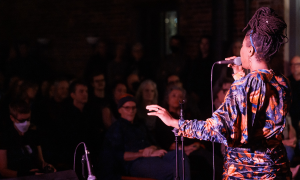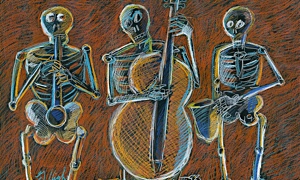Home » Jazz Articles » What is Jazz? » Transforming A Popular Song
Transforming A Popular Song
How a genius jazz musician can transform a popular song from a pleasant ditty into a thunderous rapturous experience.
There are some artists, including musicians, with the genius of, say, Picasso, that can pull this off. I thought about Picasso's Seated Woman as I listened to the album Nina Simone Live at the Village Gate. The tune is "Just in Time" from the 1956 Judy Holiday Broadway musical Bells Are Ringing, written by Julie Stein (music) and Betty Comden and Adolph Green (lyrics). It is a typical Broadway pop song, nothing wrong with it, a pleasant song. It is appealing. Now listen to Ms. Simone's version. This nice appealing song becomes before your ears a thunderously joyous gospel anthem. Instead of a romantic ditty sung by Sydney Chaplin (or Dean Martin in the movie) wooing Judy Holiday in Central Park, Nina Simone transforms a popular ballad into a spiritual, operatic shout of redemption and salvation.
Ms. Simone played this tune often in clubs and concerts; you can listen to different versions of the tune on some of her other albums and compilations, such as Live in Paris, and it is always a surprise and a wonder what she does with this simple song. In the Live in Paris version, for example, which accompanies the heartbreaking, heartwarming final scene of Richard Linkletter's movie Before Sunset, as Ms. Simone approaches the climax of the song her voice, her piano, the guitar, bass, and drums rise to a joyous crescendo as she cries out her own lyrics, chanting, "changed me, changed me," before she punctuates the performance with her euphoric "hey oh." And then, no matter what version you hear, as she expresses the song's lyrics, she is rocking the piano as only she can, her style instantly recognizable with her left hand relentlessly pounding out the addicting chords even more emphatically than Errol Garner, her right hand expounding on a dizzying array of classically derived melodies.
As the song ends I'm remembering another perfect example of the metamorphosis of a popular song, picturing in my mind the legendary Rahsaan Roland Kirk, staring at me behind pitch black shades, with his tenor, alto, and soprano saxophones all slung in a jumble around his neck. The album is Bright Moments, Kirk's live album from 1973 and contains the infectious music and Kirk's spirited presence on each track.
The track I am remembering from that album is "If I Loved You," a heartfelt composition by Rogers and Hammerstein from the musical Carousel, sung to Shirley Jones in the movie version by Gordon McCrea as their romance begins to blossom. Listening to Rahsaan Roland Kirk blasting this song (the volume level is way high), I am transported back to the 1950's—an historic boxing match between Sugar Ray Robinson, the urbane, sophisticated and adorable middleweight champion, and the hard scrapple, blue collar, craggy-faced challenger Carmen Basilio. This was in the days when boxing was as popular as football, basketball, and baseball, not the pay-for-view fringe sport and widely condemned spectacle it is today. Boxing match? It was a massacre. At the end, as Carmen Basilio sat exhausted in his corner, his left eye grotesquely swollen, his nose bloody, his face contorted in pain, I remember, even as young teenager, being bowled over by the tragic beauty of Carmen's slumping, beat-up body.
Rhasaan Roland Kirk destroys the unsuspecting Broadway tune "If I Loved You" the way Ray Robinson destroyed Carmen Basilio. This stunning performance was recorded live at the San Francisco jazz club Keystone Korner on the night of June 8, 1973. I do not know if he ever repeated that performance. It seems so spontaneously out of control. It is not pretty, a battering ram comes to mind. He plays only his tenor sax on this piece, not bothering with the flute, clarinet, stritch, nose flute, or manzello he routinely uses on stage, often playing them two or three at once, but all of his characteristic honks, blasts, asides, circular embellishments, and discordant glissandi are there in full cacophony.
But the pummeling fight analogy does not really capture another very incongruous aspect of Kirk's interpretation of "If I Loved You": it is really funny. If you like Monte Python, you are going to appreciate Kirk's boisterous rendition. I am reminded of Joey Ramone's version of the old standard "What a Wonderful World." Of course, being punk rock, Joey's reading is way less complex or harmonically interesting (no offense neo punkers). Slapstick is always part of a Rhasaan Roland Kirk performance. He is a showman. How can his playing be operatically tragic and hilarious at the same time? I have no idea. That is the wonder of Rhasaan Roland Kirk. With the ferocious coda and final climax of "If I Loved You" the audience in Keystone Korner whistled, shouted, and stomped with joy as the club's master of ceremonies, maybe the impresario or owner of the club, ran onto the stage shouting, "That was mean, that was mean." Certainly an understatement.
Those are two transformative recordings I could think of off the top of my head that knocked me out when I first heard them played by Nina Simone and Rhasaan Roland Kirk. If you think about it, it is obvious that there are plenty of other examples. John Coltrane's "My Favorite Things" is the slam dunk example that springs immediately to mind. You might wonder, if you are a Coltrane fan, what more could be said about one of the most popular jazz records of all time? The severely truncated version of the song was a big commercial success as a single when it came out in 1961 and the album was also a big seller. But so much has already been written about one of the most popular and revered jazz performances ever that there does not seem to be much more to say. I can only add that it is all about the effect that Coltrane's revolutionary modal approach had in drastically changing the course of jazz improvisation.
This revolution began with the experimental performances on George Russell's The Jazz Workshop, as well as Charles Mingus' and Gil Evans' early albums, continued with Bill Evans,' Coltrane's, and Miles Davis' seminal all-time best selling jazz record Kind of Blue, and finally wound up with the epochal "My Favorite Things" by John Coltrane. But like I said, this ground has been covered extensively by other brainier types than me and a competent discussion of modal jazz is way above my pay grade. If you are interested in George Russell and the development of modal jazz concepts, check out Modal Jazz and Miles Davis by Myles Boothroyd. See if it does not blow your mind.
Tags
History of Jazz
Rahsaan Roland Kirk
matthew sweeney
United States
California
Los Angeles
John Coltrane
Nina Simone
keystone korner
PREVIOUS / NEXT
Support All About Jazz
 All About Jazz has been a pillar of jazz since 1995, championing it as an art form and, more importantly, supporting the musicians who make it. Our enduring commitment has made "AAJ" one of the most culturally important websites of its kind, read by hundreds of thousands of fans, musicians and industry figures every month.
All About Jazz has been a pillar of jazz since 1995, championing it as an art form and, more importantly, supporting the musicians who make it. Our enduring commitment has made "AAJ" one of the most culturally important websites of its kind, read by hundreds of thousands of fans, musicians and industry figures every month.























